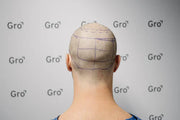Welcome back to Hair Loss 101! In our quest to unravel the mysteries of hair loss, we now turn our attention to understanding its progression. Enter the Norwood Scale – the roadmap for male pattern baldness. Let's decode this scale and see how it helps in identifying the stages of hair loss.
Summary |
|
1. What is the Norwood Scale?
The Norwood Scale, or the Norwood-Hamilton Scale, is the leading classification system used to measure the extent of male pattern baldness. Developed by Dr. James Hamilton in the 1950s and later revised by Dr. O'Tar Norwood in the 1970s, this scale provides a reference point for identifying different stages of hair loss.
2. The Stages of the Norwood Scale:
The Norwood Scale divides male pattern baldness into seven key stages:
- Stage 1: No significant hair loss or recession of the hairline.
- Stage 2: Slight recession of the hairline around the temples, often referred to as a mature hairline.
- Stage 3: First signs of clinically significant balding appear. A deepening recession at temples and possibly the beginning of a bald spot at the crown.
- Stage 3 Vertex: The hairline stays at stage 2, but there is significant loss at the crown.
- Stage 4: Hairline recession becomes more severe with sparse or no hair on the vertex. A solid band of hair separates the hairline from the crown.
- Stage 5: The areas of hair loss are larger than in stage 4. They are still separated, but the band of hair between them is narrower and sparser.
- Stage 6: The connecting bridge of hair disappears, leaving a single large bald area on the front and top of the scalp. The hair loss is more significant at the sides.
- Stage 7: The most severe stage of hair loss, only a band of hair going around the sides of the head remains. This hair may be thin and finer.
3. Why Understanding Your Stage Matters:
Knowing your stage on the Norwood Scale helps in making informed decisions about your treatment options. Early stages might respond well to medications like minoxidil and finasteride, while more advanced hair loss might require options like hair transplants.
4. Beyond the Norwood Scale: Everyone's Journey is Unique
While the Norwood Scale is a useful tool, remember that everyone's experience with hair loss is unique. Factors like hair density, scalp health, and hair color can influence how hair loss appears. It's also important to note that this scale is primarily for male pattern baldness and may not apply to other types of hair loss.
5. The Role of Genetics and Lifestyle
Genetics play a significant role in male pattern baldness, often dictating how early and how quickly one moves through the Norwood Scale stages. However, lifestyle factors like diet, stress, and health conditions can also influence hair loss.
6. Taking Action at Every Stage
Regardless of where you fall on the Norwood Scale, there are steps you can take to manage your hair loss. From lifestyle changes and medications to advanced hair restoration treatments, options are available at every stage.
7. The Gro Clinics Approach
At Gro Clinics, we use the Norwood Scale as a starting point to understand your hair loss. Our team tailor treatments to your specific stage and needs, ensuring a personalised approach to hair restoration.
Understanding where you stand on the Norwood Scale is a key step in managing hair loss. Whether you're just noticing a receding hairline or dealing with more significant loss, there's a path forward. In our next Hair Loss 101 post, we'll explore treatment options for different stages of hair loss. Remember, at Gro Clinics, we're here to guide you through every stage of your hair loss journey, offering support, expertise, and cutting-edge solutions.
Ready to take the next step? We have clinics all around Australia and New Zealand including Brisbane, Gold Coast, Sydney, Melbourne & Perth.
Why not give us a call on 1300 787 563 to start your hair growth journey.













